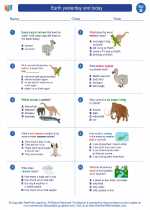Climate
Climate refers to the long-term patterns of temperature, precipitation, humidity, wind, and other atmospheric conditions in a specific region. It is different from weather, which is the short-term atmospheric conditions that can change from day to day.
Factors Affecting Climate
- Latitude: The distance of a place from the equator affects its climate. Places near the equator receive more direct sunlight and are generally warmer, while places near the poles receive less direct sunlight and are cooler.
- Altitude: Higher altitudes generally have cooler climates due to the decrease in air pressure and temperature with increasing altitude.
- Land and Water Distribution: Areas near large bodies of water tend to have milder climates compared to inland areas, as water has a moderating effect on temperature.
- Ocean Currents: Ocean currents can transfer heat across the globe and influence the climate of coastal regions.
- Wind Patterns: Global wind patterns, such as the trade winds and westerlies, can affect the distribution of temperature and precipitation in different regions.
Climate Classification
Climate is classified into different types based on temperature, precipitation, and other factors. The Köppen climate classification system is one of the most widely used classification systems, which includes categories such as tropical, dry, temperate, continental, and polar climates.
Impact of Climate Change
Climate change refers to significant and lasting changes in the statistical distribution of weather patterns over periods ranging from decades to millions of years. Human activities, such as the burning of fossil fuels and deforestation, have led to an increase in greenhouse gases, which in turn has contributed to global warming and changes in climate patterns.
Study Guide
Key Concepts
- Definition of climate
- Factors affecting climate (latitude, altitude, land and water distribution, ocean currents, wind patterns)
- Climate classification (Köppen climate classification system)
- Impact of climate change
Questions to Consider
- What is the difference between climate and weather?
- How do latitude and altitude affect climate?
- Explain the role of ocean currents in influencing climate.
- Discuss the impact of human activities on climate change.
Remember to explore real-life examples and case studies to deepen your understanding of climate and its impacts.
[Climate] Related Worksheets and Study Guides:
.◂Science Worksheets and Study Guides Second Grade. Earth yesterday and today

 Worksheet/Answer key
Worksheet/Answer key
 Worksheet/Answer key
Worksheet/Answer key
 Worksheet/Answer key
Worksheet/Answer key
 Vocabulary/Answer key
Vocabulary/Answer key
